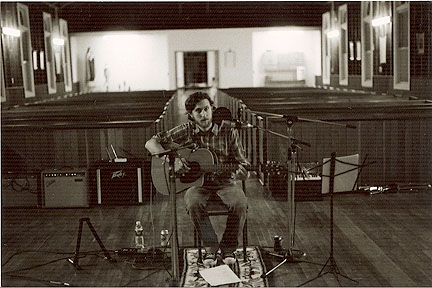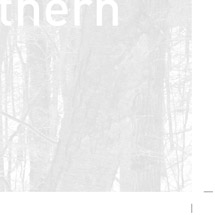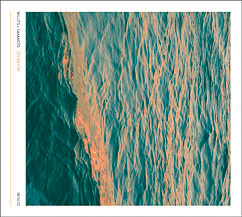PJUSK BLOG February 27, 2008
Posted by taylor in Uncategorized.add a comment

the talented and busy duo, Pjusk, have started a blog to keep us informed of their latest activities and creations.
check it out here:
INTERVIEWING GREAT LAKE SWIMMERS February 21, 2008
Posted by taylor in Uncategorized.add a comment

today i have the great pleasure of phoning Tony Dekker of Great Lake Swimmers to talk to him for an article i am writing about his music for TapeOp magazine.
Tony writes beautiful and haunting ambient folk and makes arguably the best music i’ve heard in a few years. I’ll be talking to Tony about his choice of unique acoustic spaces in which he records his albums and about the “ambience” in his music.
the article should be in print around summer or fall issues of TapeOp.
JODI CAVE: 15 QUESTIONS FROM TOKAFI February 18, 2008
Posted by taylor in Uncategorized.add a comment

15 Questions to Jodi Cave
When does a term like “unobtrusive” turn into a compliment? With Jodi Caves “For Myria”, it has happened quite naturally. The result of years of studying and experimenting, this fragile and tender work is as short as it was amazing, as precise as it is touching. In just seven tracks, most of them barely touching the four minute mark, Cave sets musical objects into motion, sending them off into a sleepwalking mode of naive exploration: The pieces on “For Myria” are little landscapes, small islands of sound on an infinite playground. Their peace, harmony and tranquility is a direct result of a positively restricted instrumentation – each track is built using a carefully selected array of sources, which are often held and played in close proximity of the microphone. Despite the dreamy character of his music, Jodi Cave is not a New Age shaman, but an academic with a heart instead, led on by an insatiable curiosity: You can almost see him smiling while listening to “For Myria”. As a consequence, it has ended up a work which will gladly fade into the background if necessary, filling the room with a soft mood of positivity. Some may call it unobtrusive for that reason, but as you should have gathered by now: In this case, that is a recommendation.
Hi! How are you? Where are you?
Hi. I’m in my flat in Glasgow. Feeling pretty good thanks.
What’s on your schedule right now?
Not working on any new recordings, but I have started producing some instrumental scores – something that I haven’t done for a while now and hope to spend a lot more time on. I’m helping my friend produce some of his songs, and also preparing my live setup for a few shows around Europe in February.
What’s your view on the music scene at present? Is there a crisis?
No, I don’t really see any crisis! I listen to all sorts of music, and can usually find something new that interests me, even if it doesn’t directly relate to what I do.
Do you see yourself as part of a certain tradition or as part of a movement?
Not really. Saying that, I am using a laptop, which has a huge impact upon the way that I think about sound, and performance. I suppose that alone would help categorize me somehow, and of course I don’t mind because it is a tool I’m using almost every day.
What, would you say, are the factors of your creativity? What “inspires” you?
This changes all the time, depending what I’m reading, looking at, listening to. The scores I am working have a strong visual component, and I guess they are informed by various approaches to form in the visual arts. This is creeping into my recorded work too, a kind of organic organization you can hear on ‘for myria’.
How would you describe your method of composing?
On the computer, I’m usually starting with some recorded sound, and trying to draw whatever music is already present in the material, by means of improvisation, and experimentation in the studio. I see it as an attempt to tune into, or articulate an organic/dynamic form, letting the sounds arrange themselves. The real challenge is to inject just the right amount of my own will on the piece, something I feel that I will struggle with for a long time.
How do you see the relationship between sound and composition?
I guess that a composition will always have some sort of human fingerprint. Even if that is only setting up a process, giving an instruction, or recording/selecting sound.
How strictly do you separate improvising and composing?
As I said earlier, when it comes to electro-acoustic composition, they are part of the same process for me. I spend most my time listening, and very little time playing/doing, and in that sense I suppose that some of my favourite improvisers are approaching sound in a similar way. But obviously, I am more of a composer, not an improviser.
What does the term „new“ mean to you in connection with music?
What is recent? Or now? I think that a lot of people interested in new (or at least experimental) music, are searching for something ground-breaking, or totally different, which of course is very difficult to imagine, what with the developments of past century behind us. For me the only way to produce something new is with from within, with a clear and open-mind, and with total dedication and personal integrity.
Do you personally enjoy multimedia as an enrichment or do you feel that it is leading away from the essence of what you want to achieve?
Recently, I’m more interested in the possibilities of pure-sound. I guess that seeing my scores, because of the way they are conceived, may help a greater appreciation of the piece. When it comes to computer music in concert, I want the sound to speak for itself.
What constitutes a good live performance in your opinion? What’s your approach to performing on stage?
This depends entirely on the music being performed. I saw a whole bunch of late-period Feldman concerts last year, by John Tilbury and members of the Smith quartet. The playing was so sensitive, with only the most necessary movement…absolutely beautiful. So I guess, when it comes to appreciating a good performance, it is a matter of necessity: If you are going to watch a band play lively music, then a lot of energy on-stage is entirely necessary.
My performances are hardly performative, but I feel this is the best way to present my work. Laptop shows are commonly met with criticism, because people expect something to watch when they go to an event. But for me (and other artists I have spoken to) it is the most effective way to present sound work in a standard live concert setting, encouraging the audience to listen first.
Do you feel an artist has a certain duty towards anyone but himself? Or to put it differently: Should art have a political/social or any other aspect apart from a personal sensation?
I can’t answer that in full here, but I’m interested in the total-abstract nature of sound, and so suppose it is an entirely personal experience. At the same time, because my own political beliefs, I wouldn’t criticise any artwork that might advocate positive change or expose social injustice.
How, would you say, could non-mainstream forms of music reach wider audiences without sacrificing their soul?
Well obviously, mainstream music is just that because it fits neatly in our day-to-day lives. Most people don’t have the time to immerse themselves in something different, and so maybe some music will only reach a smaller audience, and occasionally those middle-brow, middle-class, ‘cultured’ types.
There is always that intriguing middle ground between pop and experimentalism, which has its fair share of media exposure. I suppose it is from here that some people decide to dig a little deeper and look for something more challenging. So maybe we needn’t try too hard – I suppose that I’m most grateful for those individuals running independent, smaller scale labels/websites/magazines that people can find if they want to.
You are given the position of artistic director of a festival. What would be on your program?
Ohh, that would be fantastic..! A bit of anything, and everything that I like. Which I guess would make me the wrong person for the job.
Many artists dream of a “magnum opus”. Do you have a vision of what yours would sound like?
No, not at all! I’m too young to have ambitions like that!
AUTISTICI REVIEW ON THESILENTBALLET February 16, 2008
Posted by taylor in Uncategorized.add a comment
lots of great reviews coming in for Autistici and Willits+Sakamoto. i’ll get the press pages updated shortly. here’s a lengthy and well-written one from thesilentballet.com:
eneric terms like “experimental,” “minimal,” “subtle,” or even the nebulous “good” to describe the album, but these concepts have been stretched so loose that they don’t fit any musical work anymore. In an age when bands that play what used to be defined as “hair metal” can define themselves as “ambient” with the click of a mouse, it is clear that these definitions do not serve their intended purpose and are of minimal use to the conscientious reviewer of a complex work of music. Negative definitions do not suffice, either. To say “Volume Objects is not pop-punk, nor is it shoegaze,” does nothing to inform the prospective listener as to what the album actually is, and a list of negatives that apply to any given work would be far too unwieldy for anyone to be able to use to its intended effect. Thus, it seems that I will have to take the long route to definition, and hopefully through analysis and abstraction we will arrive at a concise definition of at least this individual work of art.
One of the aforementioned “generic” terms may still serve as a useful starting point – properly defined, of course. “Subtlety” is a trait often discussed in music, but its meaning is always taken for granted, as if there is an ideal of musical subtlety that everyone understands univocally. If there is, I’m not aware of it, and so subtlety will be defined for the purposes of this review as “the placing of greater importance on the effect of (relatively) inaccessible or less-audible portions of the piece, as opposed to that of melody, form, and structure.” To clarify, this is not to say that melody, form, and structure are not important, but rather that they are less important than the aforementioned qualities when experiencing a “subtle” work of music. Does the album fit this description? A close listen to “Wire Cage for Tiny Birds” reveals that the work is indeed “subtle.” A melody is built up, then decays, leaving only the underlying sounds for the listener to grasp. A melody is soon built up from these fragments, and then this melody decays, leaving only the seemingly insignificant underlying fragments of the melody to continue the song once more. Autisici is demonstrating the essence of subtlety, here – what makes the song is everything that runs below the surface. Even such basic qualities as melody and form are subject to, and created from, the underlying, overlooked elements of the track. So we can define Volume Objects as exhibiting “subtlety.” It is a good start, but not quite enough to characterize the entire work, however.
Autistici’s debut is also an incredibly sensual album. When I say sensual, I am not referring to the more commonly-used definition of “suggesting sexuality.” Rather, sensuality in Volume Objects relates directly to the senses, beyond the obvious auditory stimulation. Autistici is among the slowly growing number of artists that is intent on developing the tactile quality of music, focusing on the force of the sound made upon the listener’s ears, in addition to the sound itself. “To Human Form” exemplifies this strategy, tactfully shifting additional resonance into the track by selecting sounds that often oppose each other in impact upon the listener’s ear, powerfully contrasting to create a beautiful whole where one sound would be far too harsh, the other too delicate. In a bold move, Autistici also attempts to add visual stimulation to the album’s experience as well, utilizing track titles like “9v Tree Battery” and “Heated Dust on Sunlit Window” to create mental images for the listener to interact with, and by packaging the album with photographs taken by Taylor Deupree that are based upon the aforementioned titles. Even the album’s title, Volume Objects, implies sensation beyond the basic auditory experience offered by nearly all musicians. Autistici is making music using objects, and the visual/tactile properties of these objects are a part of the work just as much as the sounds that compose it.
“Space” is the final word I will use to help define Volume Objects. Autistici breathes this space into all of his compositions, allowing the tracks to be loose and conform not to a rigidly defined pattern, but to the mind of the listener. By leaving some space within the tracks empty, the definition required by most artists is lost. In this context, however, this space does not detract from the whole, but rather allows room for the listener to grab onto some of the more subtle elements of the tracks while still keeping the upper levels in focus. Though the amount of space given to the listener is large, and may tempt those less focused away from a close listen, Autistici’s clever use of space affords those with more patience to see all of the little details that make each track work so wonderfully. “Broken Guitar, Discarded Violin” is a perfect example of this trait in action (or, perhaps more precisely, inaction). The track’s arrangement is sparse, allowing each element to show itself, if subtly, and when the titular discarded violin comes into play, the close listener is rewarded with a powerful sense of fulfillment.
Now we can define Volume Objects satisfactorily. The album is a subtle exploration of various forms of sensual impression that utilizes space as a means to involve the listener in the creation of meaning within the pieces, as well as providing a means of access to the subtle within the context of the album. It is an experience that is never tiresome, never dull, and offers untold rewards to anyone who will give it a few moments of their time. There are very few albums that merit such a long, arduous definition process as this one – that alone should show just how special this experience is. Let less deserving artists be pigeonholed into ill-fitting categories, be described in awkward comparisons. To ignore this album would be to do yourself a great disservice, a crime against your musical imagination. Autistici has created a masterpiece of experimental expression, of interaction between listener and artist, and of the interaction between differing forms of art. The greatest art doesn’t defy definition, rather, it cries out to be clearly and imaginatively defined.
-Zach Mills
NORTHERN RE-MIXING February 8, 2008
Posted by taylor in Uncategorized.6 comments

over the past year there has still been demand from customers and distributors for my cd “Northern”.. it sold out fairly quickly, even after making more than i initially planned and time has come to re-issue the cd.
instead of just pressing more of the same cd and cover, however, i decided to take a slightly different approach. the cd will be released on 12k’s limited series and be a reissue much in the same vein as Shuttle 358’s “Frame”… but it is going to be completely remixed and remastered, in a slightly different way.
i have opened up the original production files (Digital Performer) from each song on the album and have been re-mixing them (not “remixing” but re-MIXING)… the catch, however, is that due to the fact that “Northern” was created 2 years ago opening the old files has lead to some missing and incompatible plug-ins (i have upgraded computer and systems since then)… resulting in effects and parts that don’t sound the same.
i have decided to use this to my advantage and rebuild or change these details with fresh ears as if they didn’t exist. The result (so far) is a “Northern” that, as well as having a general overall different mastering quality, also has some new and changed parts. on the surface, the changes are probably quite subtle… the songs sound basically the same as they did before, but those who know the work well will be able to detect the difference.
the idea is to not release a completely different album but.. what i am calling to myself, “the director’s cut” 🙂 “Northern” as i see (hear) it now, 2 years later.
the artwork will be different, to mark the new edition from the old, however, the title will be the same.. simply “Northern”.. not “Northern 2” or anything like that.
it should be released some time this spring….
WILLITS + SAKAMOTO AVAILABLE February 8, 2008
Posted by taylor in Uncategorized.add a comment

the Willits + Sakamoto cd “Ocean Fire” is now available in 12k’s online shop and starting to creep into stores. Needless to say i am very honored and proud to be releasing this work that pairs a close friend with a musical legend. I have been fortunate to be able to work with Ryuichi Sakamoto over the past couple of years, contributing to his Chain Music project, remixing some of his music and doing art for his cd covers.. and i’m so happy to see Chris and him get together for this project.